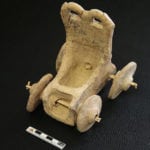 Travel
Travel  Travel
Travel  Movies and TV
Movies and TV 10 Actors Hidden in Your Favorite Movies
 Our World
Our World 10 Science Facts That Will Change How You Look at the World
 Pop Culture
Pop Culture 10 Incredible Female Comic Book Artists
 Crime
Crime 10 Terrifying Serial Killers from Centuries Ago
 Technology
Technology 10 Hilariously Over-Engineered Solutions to Simple Problems
 Miscellaneous
Miscellaneous 10 Ironic News Stories Straight out of an Alanis Morissette Song
 Politics
Politics 10 Lesser-Known Far-Right Groups of the 21st Century
 History
History Ten Revealing Facts about Daily Domestic Life in the Old West
 Weird Stuff
Weird Stuff 10 Everyday Products Surprisingly Made by Inmates
 Travel
Travel 10 Natural Rock Formations That Will Make You Do a Double Take
 Movies and TV
Movies and TV 10 Actors Hidden in Your Favorite Movies
 Our World
Our World 10 Science Facts That Will Change How You Look at the World
Who's Behind Listverse?

Jamie Frater
Head Editor
Jamie founded Listverse due to an insatiable desire to share fascinating, obscure, and bizarre facts. He has been a guest speaker on numerous national radio and television stations and is a five time published author.
More About Us Pop Culture
Pop Culture 10 Incredible Female Comic Book Artists
 Crime
Crime 10 Terrifying Serial Killers from Centuries Ago
 Technology
Technology 10 Hilariously Over-Engineered Solutions to Simple Problems
 Miscellaneous
Miscellaneous 10 Ironic News Stories Straight out of an Alanis Morissette Song
 Politics
Politics 10 Lesser-Known Far-Right Groups of the 21st Century
 History
History Ten Revealing Facts about Daily Domestic Life in the Old West
 Weird Stuff
Weird Stuff 10 Everyday Products Surprisingly Made by Inmates
10 Troubling Items Left In Patients After Surgery
Going into surgery can be scary enough; depending on the procedure, there can be many steps and preventative measures that need to be taken to ensure that the patient will recover completely. Trusting in the staff, from the nurses to the doctors to the surgeons themselves, is a leap of faith.
TV shows like Grey’s Anatomy and ER have prepared the viewer to expect the worst: blood flying, body parts being cut off, organs not getting there in time. The reality is less dramatic—well, almost. With an estimated 28 million surgeries preformed yearly, mistakes can be made.[1] However, the mistakes made in the following surgeries are those stemming from the creation of one’s worst nightmares. Ranging from towels to needles to even whole instruments, patients found out after they left the operating room that they were left with mementos from their procedures they hadn’t expected, or wanted.
Though surgeries may not be a dramatic as they are on TV, finding out that something is in your body that shouldn’t be isn’t what you want to hear after you’ve already been sewn back up.
10 The Gloves Are Off

Having surgery to stop her heavy menstruation was supposed to be the end of one French woman’s problems. The procedure, which she underwent in April 2017, was new, something that would be aid in stopping periods without being a full-blown hysterectomy.[2] The promise was that once her surgery was completed, she wouldn’t be experiencing any more bleeding or pain.
However, the woman, who was told her operation went well and that there were no complications, did not feel anything near relief. After her surgery, she began feeling pain in her lower adbomen—the exact reason she had gone in to begin with. This pain led to a loss of sleep and her constantly feeling ill. Unable to handle it any longer, she called her doctor, who attributed it to her weight and gave her painkillers.
The painkillers did nothing to stop her pain, however, and after three days, she began to feel sharp stabs of pain due to contractions. Her contractions resulted in her pushing out a glove and five compresses that had been left inside her during her procedure, as well as a large pool of blood that led to her being sent to the hospital.
A similar case happened to a woman in England in 2013, when a routine hysterectomy left the woman in severe pain. The pain continued three days after Sharon Birks’s surgery, and she was provided antibiotics by her doctors, as they believed her procedure had likely resulted in an infection.
However, the pain didn’t stop. Though Mrs. Burks began to believe it was her catheter, a trip to the bathroom proved otherwise. While in the bathroom, the pain was accompanied by pressure, and a surgical glove came out of her. While no damage occurred, the experience itself was apparently horrifying enough.
Talk about unexpected births.
9 Needle In A Haystack
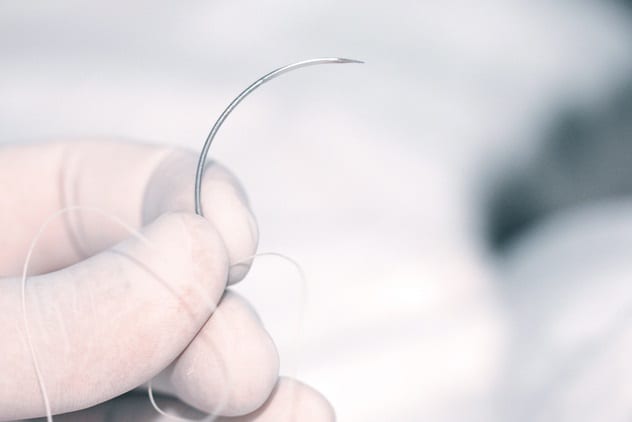
The old adage “finding a needle in a haystack” relates to trying to find something that cannot easily be found. In this case, the adage applies to a Tennessee man who died after surgeons left a needle inside him in May 2017.[3]
John Burns Johnson had just come out of a nine-hour heart surgery when his surgeon realized that he was missing a needle. Confirming through X-ray that the needle was, in fact, still inside Mr. Johnson, a second operation was conducted. It’s uncertain if the needle couldn’t be found or removed, but nevertheless it remained inside Mr. Johnson.
Mr. Johnson unfortunately passed away a month later due to the complications caused by the needle’s presence in his body. The needle was found and removed during his autopsy.
As shocking as this is, it isn’t the only time this has happened. A woman found out there was an epidural needle left in her back, 14 years after her caesarean surgery back in 2003. The Florida woman had experienced back pain for years but did not realize it was a serious issue until an X-ray showed the epidural needle had broken into three places along her spine. The needle being left behind resulted in nerve damage along her spine and severe scarring.
In case you’re rethinking surgeries, never fret; only ten percent of the items found inside patients end up being needles.
8 Throw In The Towel

A California man went into his doctor’s expecting the worst-case scenario when it came to his diagnosis. Months after an April 2014 abdominal surgery for bladder cancer, he started to experience pain in his bowels, along with a sense of fatigue and an inability to even drive himself to his appointments. Though he had expected a diagnosis that the previously treated cancer had spread, it turned out that the mass which had been causing all his pain was not cancer but, shockingly enough, a towel.
Despite all the surgical instruments being accounted for, the surgical team forgot to keep track of the towels used during surgery. This lead to a misplaced towel ending up in this man’s abdomen, where it caused him a myriad of health problems, not to mention the fear that his cancer was spreading.
Towels being left in patients is not unheard-of; they account for 2.1 percent of items left inside patients during surgery and are undetectable by X-rays. In 1995, an Ohio woman went in for lung surgery and left feeling off. The feeling that something was sitting in her chest stayed until she passed away seven years later. It wasn’t until the autopsy that they found the cause of her pain: a green towel which had been balled up and left in her lung.[4]
Unfortunately, it was too late to correct the problem, but it did explain the woman’s odd feeling of something moving in her chest despite it nothing being found on X-rays. In the case of the California man, he made a full recovery, and the doctor who performed the surgery was fired. The man sued the hospital to help soak up the damages.
7 No Sponge About It
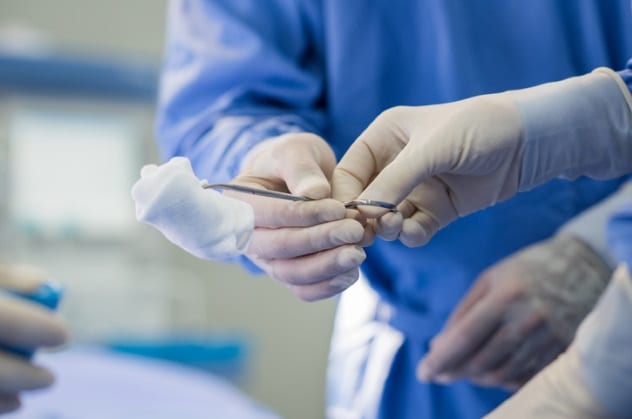
Bleeding is an unfortunate side effect of surgery, and using sponges is common practice to ensure that the blood doesn’t spread. Leaving the sponge inside the patient, however, is not.
A woman in Japan experienced strange abdominal bloating for three years off and on, with no explanation. After she went to the doctor in hopes of finding the culprit, test results revealed that she not one but two sponges inside her abdomen. The sponges were believed have been left in there during her caesarean six years prior and had attached themselves to the folds connecting her stomach and abdomen as well as her colon.
While surgery provided her much-needed relief, sponges being left inside patients is quite common. Roughly 70 percent of the items found in patients are sponges, and they can do lethal damage. Almost two-thirds of cases where items such as sponges were left inside patients have led to serious infection, injury, and even death.
In 2007, another woman who had a sponge left inside her after a dual bladder and hysterectomy surgery left her feeling ill. Doctors claimed it was a gastrointestinal issue and sent her home, but when the pain began to be accompanied by bleeding, her gynecologist believed it was an ovarian cyst. After her ovaries were removed, the pain continued, and subsequent tests showed that a mass had gathered in her intestines. This mass had been blocked previously by her ovaries, but its identity was obvious now: A sponge had been left behind and had embedded itself into her body. After yet another surgery, and having a large portion of her intestines removed, the sponge was taken out.[5]
6 Wire Not?
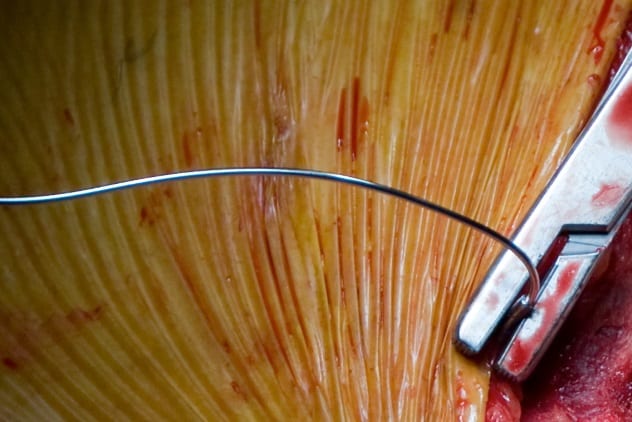
Wires are a common instrument used in surgeries, and depending on the procedure, some have to be kept in the body. However, in the case of a patient in England, a wire was left behind after a routine surgery in August 2018. The wire wasn’t noted as missing until 12 hours later. Luckily, that was still soon enough that the patient suffered no side effects, and a follow-up surgery was scheduled to remove it.
A similar heart-wrenching case happened to Donald Gable in Philadelphia. After his heart surgery, Gable returned home feeling fine. It wasn’t until a follow-up with his doctors that he found out that a 0.6-meter (2 ft) wire had been sitting in his chest for six weeks. Thankfully, the wire was able to be removed, though Mr. Gable was lucky it didn’t pierce a vein, given its precarious positioning.
Wires are often used to aid doctors in guiding instruments to where they need to be. At the Albany Medical Center, two wires were left behind in patients during surgeries. One wire had been used for guiding during a catheter procedure. It wasn’t until the patient had an X-ray done that doctors were able to locate and remove it.
The other incident occurred during a caesarean, during which the wire from a probe was accidentally cut. While the staff were aware the piece of the wire was missing, they didn’t believe it was inside the woman and closed her stitches. Yet again, it wasn’t until she went in for X-rays later that the wire was discovered.[6]
Though no major damage occurred from these accidents, surgical staff were mostly certainty cutting it too close to the wire.
5 Rock, Paper . . . Scissors?
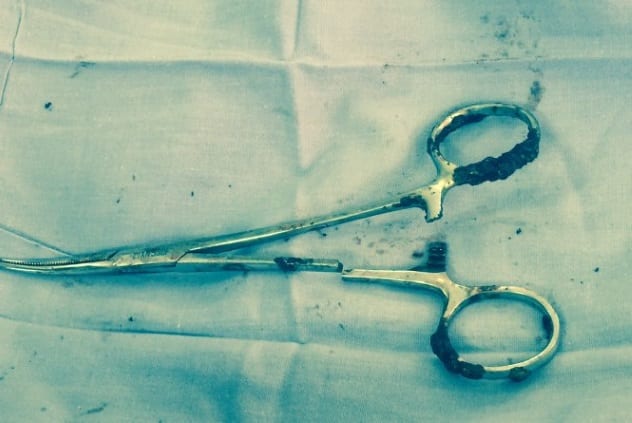
During childhood, it’s almost too common for parents to have to remind their children to be careful with scissors. For a woman in Australia, the same warning should have been given to her surgeon.
After going in for surgery in 2001 to remove part of her colon, 69-year-old Pat Skinner experienced pain but had been instructed that because of the nature of her surgery, this was to be expected. The pain didn’t stop, and although doctors claimed it was because of the surgery, Mrs. Skinner didn’t think so. This pain wasn’t similar to the uncomfortable feeling doctors warned her about; it was much, much worse. Turns out, Mrs. Skinner was correct.
An X-ray performed by her general practitioner showed that 18-centimeter (7 in) scissors had been left inside her during her surgery. The scissors had become wedged against her tailbone, causing much of her excruciating pain. Unfortunately, by the time the scissors were noticed, tissue had begun to grow over them, and a more extensive surgery had to be done to remove them, resulting in doctors having to remove part of her bowels as well.
Shockingly, this isn’t the only time this has happened. In 2016, a man who had received surgery after an accident 18 years prior began experiencing abdominal pain that didn’t seem to abate despite receiving meds. An X-ray revealed that scissors from the prior operation (pictured above) were still inside the man, identified as “M.V.N.” The scissors, which had rusted due to being left inside his body for so long, had to be removed in a three-hour-long surgery due to the rusted handles being embedded in some of his organs.[7] Despite the scissors being in M.V.N. for 18 years, he made a full recovery and was sent home within days.
It seems the doctors weren’t playing with scissors; they were playing with their patient’s lives.
4 To Scalpel Or Not To Scalpel?
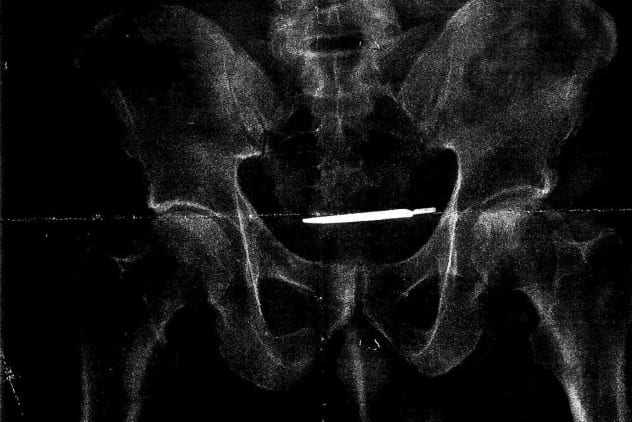
A surgeon can only be as good as their hands and their tools, which is why it’s surprising when a surgeon loses said tools . . . inside their patient.
This shock came to an Army veteran who underwent surgery in 2013 to remove his prostate after a cancer diagnosis. The surgery went on longer than expected, but Mr. Glenford Turner was not told of any complications or given any indication that there was anything amiss. The pain, however, did not fade, despite the doctor’s reassurances that it would. After four years, Mr. Turner went back in to see his doctor due to unrelenting abdominal pain.
What they found was not a tumor but a foreign object. The scalpel (pictured above) was confirmed to be from his prior surgery and had been left inside him, moving between his bladder and rectal area, causing much of his pain.
Thankfully, the scalpel was able to be removed. This is unlike the case of Victor Hutchison, who was admitted to the hospital after experiencing what he thought were gallbladder issues. Once he was brought in for an X-ray, it was obvious that his gallbladder was not the problem. Months earlier, Mr. Hutchinson had undergone heart bypass surgery in which the scalpel used in the procedure had gone missing. While staff were aware of the missing scalpel, they couldn’t find it and had checked Mr. Hutchinson’s chest using an X-ray, only to come up empty-handed.
Unknown to the surgical staff, the scalpel had left the chest cavity and had lodged itself in Mr. Hutchinson’s abdominal cavity around his spine. Once the scalpel had been found during his subsequent X-ray, the doctors ruled that it was in too precarious of a position to be removed.[8] Of all the mementos to keep, it’s doubtful Mr. Hutchinson wanted to keep this one from his surgery.
3 You’ve Got This, Clamp

Clamps are very useful during surgery, due to their ability to keep things in place when everything else seems to be moving. They’re so helpful, in fact, that they’re sometimes forgotten about. That is, until the patient is rudely reminded.
Sometimes, even the most routine procedures can lead to harrowing results. After going in for a routine surgery to remove their gastric band in 2011 caused one unnamed patient to end having much more removed. While it seemed that the surgery went well, surgical staff had not realized that a 20-centimeter (8 in) clamp had been left inside the patient. The clamp was detected three days later, and another operation was scheduled to remove it. During this surgery, the patient began to unexpectedly bleed profusely and ultimately had to have their spleen removed.[9]
2 Retract This!
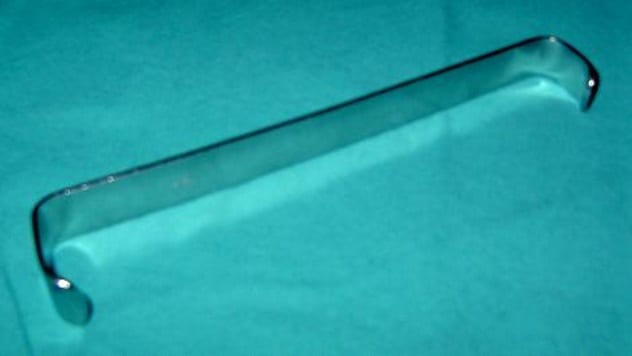
Retained foreign bodies do occasionally happen, and while objects such as sponges, gauze, and needles are more likely, whole objects such as scissors, wires, and even entire retractors are not unheard-of.
A man in Seattle can testify to this after he continued to have pain following his surgery in 2000. His doctor reassured him that the pain was normal and could last a month after the procedure. However, after setting off metal detectors in an airport, Mr. Donald Church went to his physician to get a second opinion. A CAT scan showed that an entire 33-centimeter-long (13 in) retractor had been left inside him during his surgery to remove a cancerous tumor a month prior. The retractor had been putting pressure on his abdomen and chest, making him feel as if he was slowing dying.
This incident occurred at the University of Washington Medical Center, which admitted in the subsequent lawsuit against them that this is not the first time such a thing had happened. In fact, almost a year prior, a woman had a retractor left inside her during her surgery to remove her cancer. The retractor had remained inside her for almost a month before doctors realized what was causing the pain.
While these incidents were quickly handled, one unnamed patient wasn’t so lucky. His pain lasted off and on for 27 years after his surgery in 1979 to remove polyps in his abdomen. After the operation, the patient felt pain in his side, though doctors attributed it to an abdominal hematoma. However, two decades and some change later, during an X-ray, doctors noticed a large metal mass on the side of his pelvis. The culprit was a 28-centimeter (11 in) surgical retractor which had been overlooked after his first surgical X-rays, 27 years prior.[10]
Despite the name, it seems that doctors easily forget to retract the objects they use in surgery.
1 Everything But The Kitchen Sink
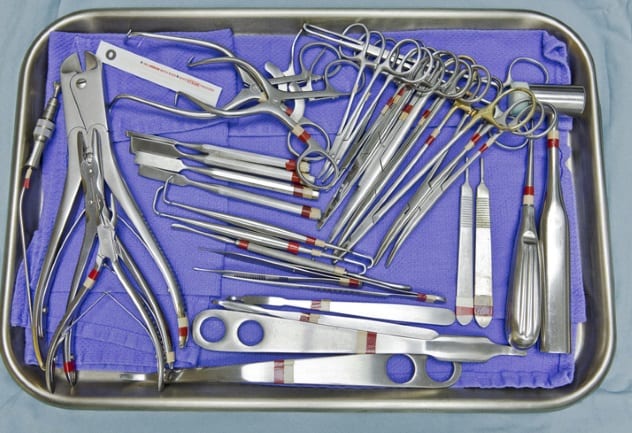
While many of these cases seem troubling, nothing is as disturbing as a man going in for cancer surgery and leaving with 16 additional problems. Those problems? Surgical items which had been left inside him during the procedure.
Dirk Schroeder’s 2009 surgery was supposed to be an easy procedure, one with minor side effects. What Mr. Schroeder experienced post-surgery was the complete opposite. After his operation, Mr. Schroeder experienced pain, fatigue, discomfort, and illness. Still, his doctors believed it was all expected as part of his recovery. That was until his home health care nurse noticed a gauze pad in a place it shouldn’t be: coming out of Mr. Schroder’s stitches.[11] Scans found that there were 16 items left in his body during his surgery, including: swabs, a 15-centimeter (6 in) roll of bandage, a compress, needles, and other surgical tools, including part of a surgical mask, which had been impairing his body’s ability to heal correctly.
A total of 1,500 patients a year experience items being left inside them during surgery. They range from gauze to large tools, but rarely are multiple different items left in a patient. For Mr. Schroeder, it cost him two more surgeries to get the 16 objects, either whole or in fragments, out of his body.
How the staff didn’t notice a large number of their tools missing after the surgery is the question both Mr. Schroeder’s family and everyone would like answered.
Read about more surgical nightmares on 10 Unimaginable & Horrific Botched Surgeries and 10 People Who Woke Up During Surgery.


